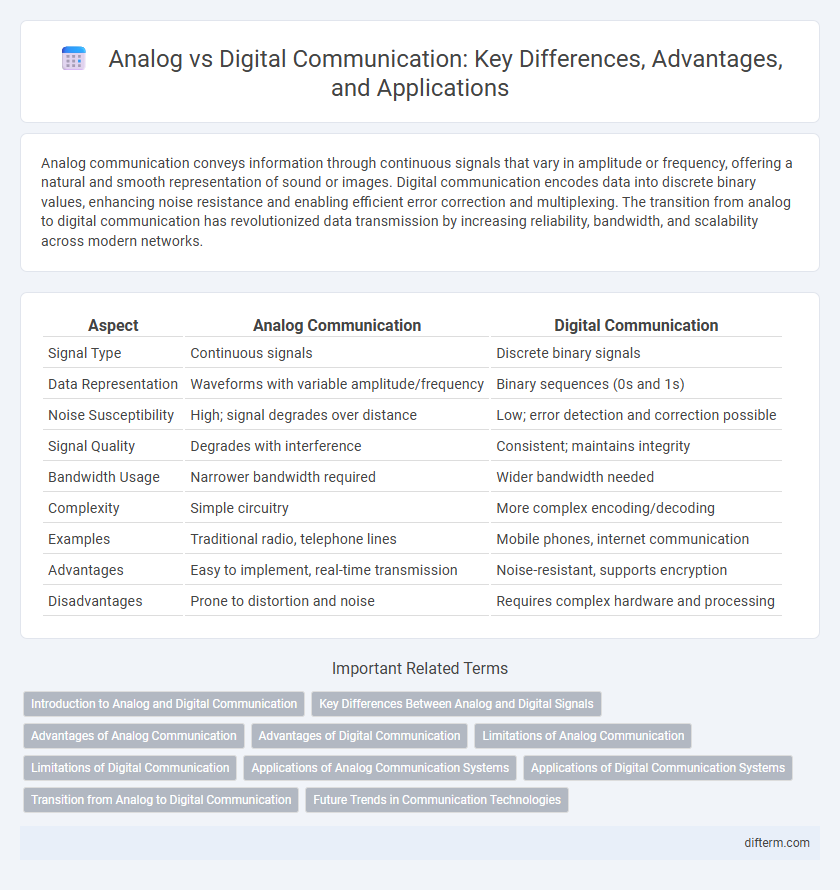Analog communication conveys information through continuous signals that vary in amplitude or frequency, offering a natural and smooth representation of sound or images. Digital communication encodes data into discrete binary values, enhancing noise resistance and enabling efficient error correction and multiplexing. The transition from analog to digital communication has revolutionized data transmission by increasing reliability, bandwidth, and scalability across modern networks.
Table of Comparison
| Aspect | Analog Communication | Digital Communication |
|---|---|---|
| Signal Type | Continuous signals | Discrete binary signals |
| Data Representation | Waveforms with variable amplitude/frequency | Binary sequences (0s and 1s) |
| Noise Susceptibility | High; signal degrades over distance | Low; error detection and correction possible |
| Signal Quality | Degrades with interference | Consistent; maintains integrity |
| Bandwidth Usage | Narrower bandwidth required | Wider bandwidth needed |
| Complexity | Simple circuitry | More complex encoding/decoding |
| Examples | Traditional radio, telephone lines | Mobile phones, internet communication |
| Advantages | Easy to implement, real-time transmission | Noise-resistant, supports encryption |
| Disadvantages | Prone to distortion and noise | Requires complex hardware and processing |
Introduction to Analog and Digital Communication
Analog communication transmits information using continuous signals that vary in amplitude, frequency, or phase, representing real-world data like sound and light waves. Digital communication encodes information into discrete binary signals, offering higher noise resistance, improved signal integrity, and easier data compression. Key components include analog-to-digital converters (ADC) for signal sampling and digital modulation techniques such as QAM and PSK.
Key Differences Between Analog and Digital Signals
Analog signals vary continuously, representing information through fluctuations in amplitude, frequency, or phase, whereas digital signals use discrete binary values, typically represented as 0s and 1s. Analog communication is more susceptible to noise and distortion during transmission, making signal degradation a common issue, while digital communication offers greater noise resistance and error detection capabilities. The bandwidth efficiency differs significantly; digital systems can compress data effectively, enhancing transmission capacity compared to analog systems that require broader bandwidth for the same information.
Advantages of Analog Communication
Analog communication offers superior signal quality in real-time transmission, providing smooth and continuous waveforms that closely replicate original sounds or images. It requires simpler hardware and is highly effective for short-distance communication with minimal interference. The natural representation of information in analog signals enhances the perception of nuances such as tone and emotion in voice communication.
Advantages of Digital Communication
Digital communication offers superior noise resistance, ensuring clearer signal transmission compared to analog systems. It enables efficient data compression and error detection, optimizing bandwidth usage and enhancing reliability. Integration with modern computing technologies facilitates versatile applications and seamless connectivity across networks.
Limitations of Analog Communication
Analog communication faces limitations such as susceptibility to noise and signal degradation over long distances, leading to reduced signal quality and clarity. Bandwidth constraints restrict the amount of information transmitted simultaneously, causing lower efficiency compared to digital methods. Furthermore, analog signals lack effective error detection and correction mechanisms, making them less reliable in maintaining data integrity.
Limitations of Digital Communication
Digital communication faces limitations such as signal degradation over long distances, data compression losses, and latency issues affecting real-time interactions. Bandwidth constraints and susceptibility to cybersecurity threats can compromise data integrity and transmission speed. Despite error-correction technologies, digital systems still encounter challenges in preserving the nuance and quality found in analog signals.
Applications of Analog Communication Systems
Analog communication systems are widely used in applications such as traditional radio broadcasting, analog television transmission, and telephone networks that rely on continuous signal variations for voice communication. These systems excel in transmitting audio signals over short to medium distances, preserving signal fidelity in environments with minimal noise interference. Despite the rise of digital communication, analog methods remain critical in aviation radio communication, AM/FM radio, and certain sensor technologies where real-time signal processing is essential.
Applications of Digital Communication Systems
Digital communication systems are widely used in telecommunications, including mobile networks, satellite communication, and internet data transmission, due to their robustness against noise and efficient bandwidth utilization. They enable applications such as video conferencing, streaming services, and digital broadcasting, which require high fidelity and secure data transfer. The integration of error detection and correction algorithms enhances reliability, making digital communication essential in modern wireless and wired communication infrastructures.
Transition from Analog to Digital Communication
The transition from analog to digital communication has revolutionized data transmission by enhancing signal clarity, reducing noise interference, and increasing bandwidth efficiency. Digital communication enables seamless integration with modern networks, supports advanced encryption protocols, and facilitates real-time data processing. This shift underpins the development of technologies like 5G, VoIP, and high-definition streaming, drastically improving communication speed and reliability.
Future Trends in Communication Technologies
Future trends in communication technologies emphasize the rapid expansion of digital communication, driven by advancements such as 5G networks, Internet of Things (IoT), and artificial intelligence integration. Analog communication is increasingly being replaced due to its limitations in data capacity and susceptibility to noise, while digital systems offer higher bandwidth, error correction, and encryption capabilities. Emerging technologies like quantum communication and edge computing promise to further revolutionize secure, high-speed data transmission in the coming decades.
analog vs digital communication Infographic

 difterm.com
difterm.com